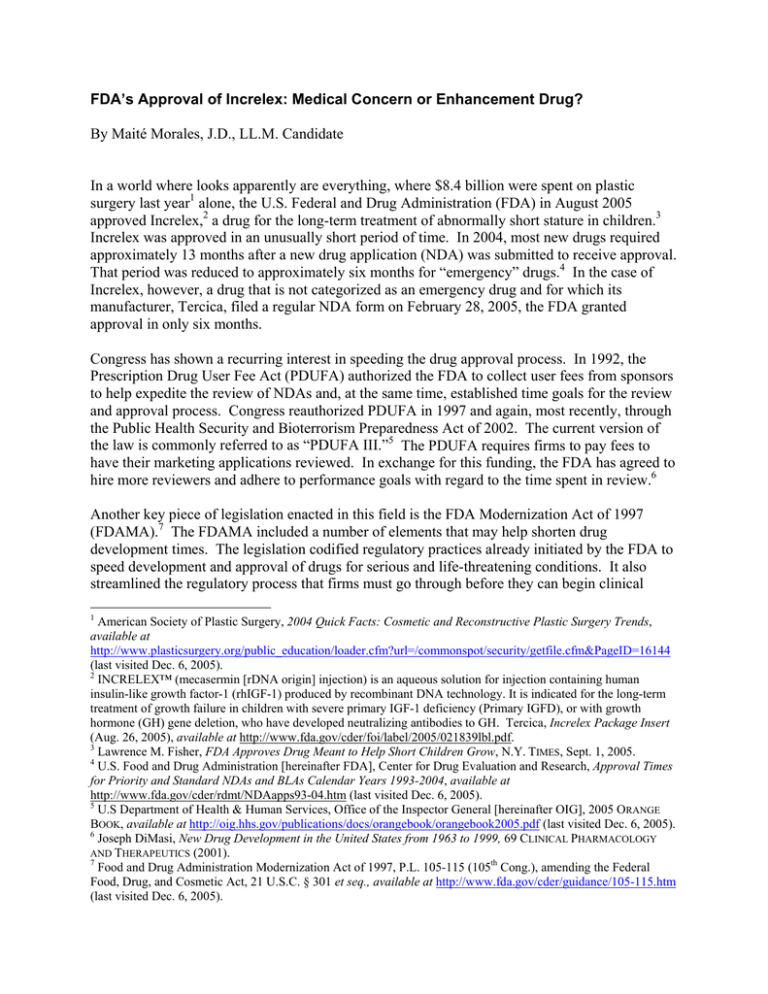FDA’s Approval of Increlex: Medical Concern or Enhancement Drug?
advertisement

FDA’s Approval of Increlex: Medical Concern or Enhancement Drug? By Maité Morales, J.D., LL.M. Candidate In a world where looks apparently are everything, where $8.4 billion were spent on plastic surgery last year1 alone, the U.S. Federal and Drug Administration (FDA) in August 2005 approved Increlex,2 a drug for the long-term treatment of abnormally short stature in children.3 Increlex was approved in an unusually short period of time. In 2004, most new drugs required approximately 13 months after a new drug application (NDA) was submitted to receive approval. That period was reduced to approximately six months for “emergency” drugs.4 In the case of Increlex, however, a drug that is not categorized as an emergency drug and for which its manufacturer, Tercica, filed a regular NDA form on February 28, 2005, the FDA granted approval in only six months. Congress has shown a recurring interest in speeding the drug approval process. In 1992, the Prescription Drug User Fee Act (PDUFA) authorized the FDA to collect user fees from sponsors to help expedite the review of NDAs and, at the same time, established time goals for the review and approval process. Congress reauthorized PDUFA in 1997 and again, most recently, through the Public Health Security and Bioterrorism Preparedness Act of 2002. The current version of the law is commonly referred to as “PDUFA III.”5 The PDUFA requires firms to pay fees to have their marketing applications reviewed. In exchange for this funding, the FDA has agreed to hire more reviewers and adhere to performance goals with regard to the time spent in review.6 Another key piece of legislation enacted in this field is the FDA Modernization Act of 1997 (FDAMA).7 The FDAMA included a number of elements that may help shorten drug development times. The legislation codified regulatory practices already initiated by the FDA to speed development and approval of drugs for serious and life-threatening conditions. It also streamlined the regulatory process that firms must go through before they can begin clinical 1 American Society of Plastic Surgery, 2004 Quick Facts: Cosmetic and Reconstructive Plastic Surgery Trends, available at http://www.plasticsurgery.org/public_education/loader.cfm?url=/commonspot/security/getfile.cfm&PageID=16144 (last visited Dec. 6, 2005). 2 INCRELEX™ (mecasermin [rDNA origin] injection) is an aqueous solution for injection containing human insulin-like growth factor-1 (rhIGF-1) produced by recombinant DNA technology. It is indicated for the long-term treatment of growth failure in children with severe primary IGF-1 deficiency (Primary IGFD), or with growth hormone (GH) gene deletion, who have developed neutralizing antibodies to GH. Tercica, Increlex Package Insert (Aug. 26, 2005), available at http://www.fda.gov/cder/foi/label/2005/021839lbl.pdf. 3 Lawrence M. Fisher, FDA Approves Drug Meant to Help Short Children Grow, N.Y. TIMES, Sept. 1, 2005. 4 U.S. Food and Drug Administration [hereinafter FDA], Center for Drug Evaluation and Research, Approval Times for Priority and Standard NDAs and BLAs Calendar Years 1993-2004, available at http://www.fda.gov/cder/rdmt/NDAapps93-04.htm (last visited Dec. 6, 2005). 5 U.S Department of Health & Human Services, Office of the Inspector General [hereinafter OIG], 2005 ORANGE BOOK, available at http://oig.hhs.gov/publications/docs/orangebook/orangebook2005.pdf (last visited Dec. 6, 2005). 6 Joseph DiMasi, New Drug Development in the United States from 1963 to 1999, 69 CLINICAL PHARMACOLOGY AND THERAPEUTICS (2001). 7 Food and Drug Administration Modernization Act of 1997, P.L. 105-115 (105th Cong.), amending the Federal Food, Drug, and Cosmetic Act, 21 U.S.C. § 301 et seq., available at http://www.fda.gov/cder/guidance/105-115.htm (last visited Dec. 6, 2005). testing, codified the authority that the FDA has to approve new drugs on the basis of a single well-controlled trial, and required the FDA to establish procedures to quickly resolve scientific disputes with sponsors and to hold meetings with sponsors in a timely fashion during the development process.8 One of the main problems with these pieces of legislation is that the FDA is relying primarily on information supplied by and tests commissioned by pharmaceutical manufacturers themselves, rather than the FDA conducting its own investigations. This practice automatically creates some level of bias in favor of the drugs seeking approval. Some studies critical of the drug approval process have argued that any effort to speed the approval of new drugs inevitably creates the risk that truncated studies and review will result in the release of drugs with unknown hazards and effectiveness.9 On the other hand, an evaluation performed by the Office of the Inspector General of the U.S. Department of Health and Human Services in 2005 found that the FDA drug application review process has its strengths. These include collaboration with drug sponsors, responsiveness to time goals, and increased efforts to improve efficiency and consistency, thus increasing both reviewers’ and sponsors’ level of confidence in FDA decisions. Nonetheless, heavy workload pressures present challenges to the effectiveness of the review process. This is demonstrated in reviewer concerns about time pressures, staff turnover, decreased use of advisory committees, and less time for reviewers to participate in professional development and research activities.10 In the case of Increlex, studies by Tercica show that the drug has the following side effects: hypoglycemia, bruising, otitis media, headache, dizziness, convulsions, vomiting and cardiac murmur among others. One of the main concerns is the risk of developing hypoglycemia because hypoglycemia was reported by 30 subjects (42%) at least once during their course of therapy.11 The FDA received complaint letters, even from a biopharmaceutical company asking for the denial of approval of Increlex, alleging that Tercica has failed to adequately show the safety of this investigational new drug.12 There are no clinical studies on the effect the drug will have on children under the age of two, on nursing mothers, or on unborn children. Hopefully, this new drug won’t become the next Vioxx or Bextra, but in an era where rushed approvals may have had lethal results, it’s inevitable that the speed of Increlex’s approval may raise concerns about this new drug. Certainly there may be children out there who may benefit from the use of Increlex, but who is to judge who is tall enough? Why a <3 deviation instead of a 2 or a 4? In a world where low selfesteem is the order of the day, pharmaceutical companies continue to profit from every single “flaw” known to mankind regardless of costs or side effects. I am a firm believer of evolution 8 DiMasi, supra note 6. Mark A. Hall, David Orentlicher, Mary Anne Bobinski, MEDICAL LIABILITY AND TREATMENT RELATIONSHIPS 172 (2004). 10 OIG, FDA’S REVIEW PROCESS FOR NEW DRUG APPLICATIONS, March 2003, OEI-01-01-00590, available at http://oig.hhs.gov/oei/reports/oei-01-01-00590.pdf. 11 See Increlex Package Insert, supra note 2. 12 See, e.g., Insmed, Inc., Citizen Petition, Aug. 10, 2005, available at http://www.fda.gov/ohrms/dockets/dockets/05p0322/05p-0322-cp00001-02-vol1.pdf. 9 2 and in the advances achieved through genetics, but in a world of frankenfoods, enhancement drugs, cloning and DNA modification, where are we leaving the Darwinian style of life? December 2005 3






